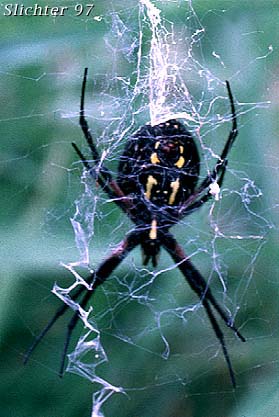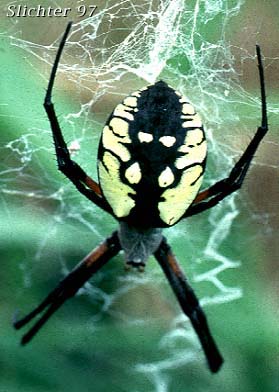

 Upper surface of black
and yellow garden spider from Sauvie Island, west of Portland, OR.......August
22, 1994.
Upper surface of black
and yellow garden spider from Sauvie Island, west of Portland, OR.......August
22, 1994.
Its body is generally 1/16" to 1 3/4" long. With the legspan, some individuals may cover much of the surface of ones palm. The body is mostly hairless, and has a yellow and black patterned abdomen. Its legs may be somewhat hairy. This spider weaves a somewhat circular web, with many sections radiating outward from the center. Webs are suspended vertically in trees, bushes, or anywhere there is an opening through which flying insects may pass. The garden spider typically hangs at the center of the web, with its head hanging down.
Readers, this spider is not poisonous to us! It is essentially harmless, despite its size. As I hike through neighboring woods during the fall, I frequently run into their large webs, and they (the spiders) often are on my head or chest. In my experience, they seem to want to get off of me as fast as I want to get them off! Remember, that despite their fearsome appearance, they help rid us of lots of pesky insects!
As with all animals, they go through population swings, increasing in times of greater food, decreasing when there is less food. If you see one in your yard and have never seen them before, more than likely they were there, or in the neighborhood......you probably just never noticed them. In addition, if there are suddenly many garden spiders in your locality, the mom probably laid the egg case in a very successful place, ensuring that more young would survive (in other words, out of the weather and in a place where the young had access to more food!). In my experience, I think I've seen a couple individuals survive mild winters and establish webs a second year.